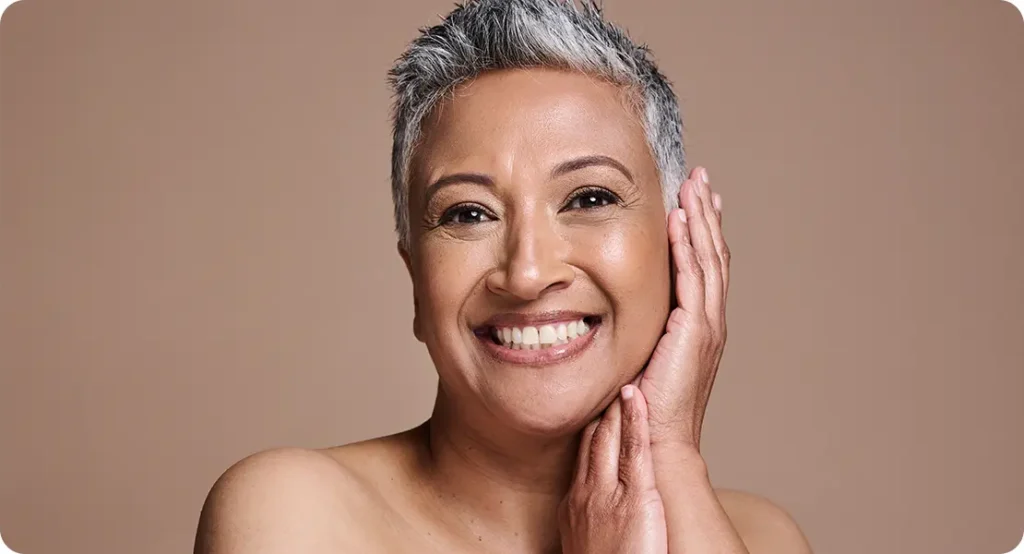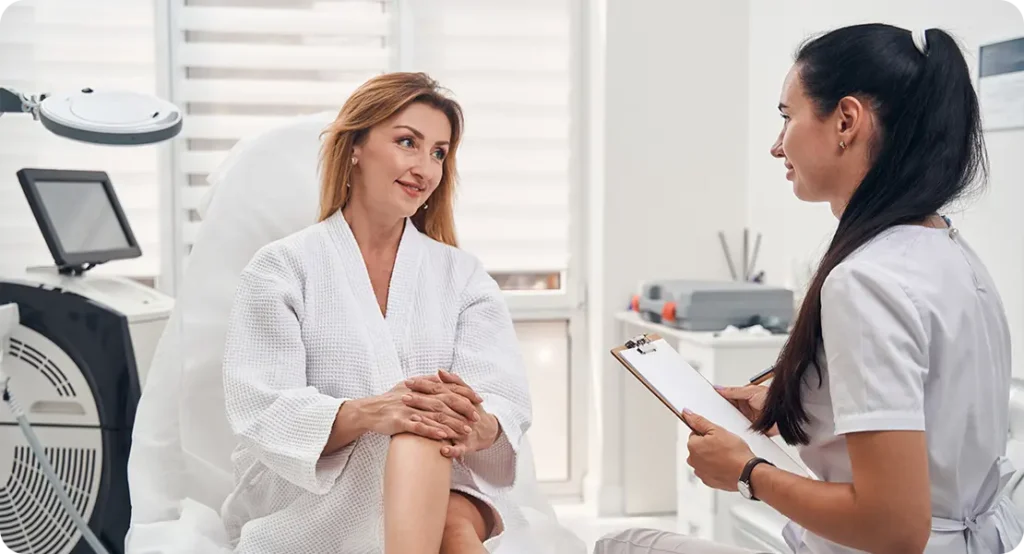Menopause marks a major transition not just for your reproductive system, but for your skin as well. If you’ve started noticing your complexion feeling drier, thinner, or more sensitive than before, you’re not imagining it. These changes are often the result of shifting hormones, especially the decline in oestrogen, and they can show up gradually or seemingly overnight.
Oestrogen plays a vital role in maintaining the skin’s structure, hydration, and elasticity. As its levels drop, your skin loses some of its natural defences against dryness, inflammation, and environmental damage. That youthful glow may start to fade, fine lines might appear more pronounced, and even old foes like acne can suddenly make a comeback.
Many women find this period confusing and frustrating especially when the skincare products and routines that once worked no longer deliver the same results. But there’s good news: understanding what’s happening beneath the surface can empower you to make smart, supportive changes.
This guide breaks down why your skin reacts the way it does during menopause and offers science-backed solutions to help you adapt. With the right care, your skin can still look and feel healthy, radiant, and resilient through menopause and beyond.
It’s also important to remember that these skin changes are completely normal yet often under-discussed. Many women feel caught off guard by the shift in their skin’s behaviour, not realising it’s a natural part of the menopausal process. Opening up the conversation around this topic can help reduce the stigma and empower more people to seek the care and knowledge they deserve. Just as your body evolves, your skincare should too adapting to new needs like enhanced hydration, barrier repair, and targeted treatments for concerns like pigmentation or loss of firmness. With a few thoughtful adjustments and a focus on self-care, this new phase can be embraced with confidence and clarity. After all, caring for your skin is another way of caring for yourself.
What’s Happening to Your Skin During Menopause?
If you’ve recently started noticing that your skin feels drier, more sensitive, or just not the same as it used to be, menopause could be a major contributing factor. These changes aren’t random they’re closely tied to the hormonal shifts your body experiences during this phase of life. One of the most significant changes is the decline in oestrogen, a hormone that plays a crucial role in maintaining your skin’s structure and vitality.
Oestrogen helps to boost collagen production, support skin hydration, and maintain thickness and elasticity. As levels of this hormone drop during perimenopause and menopause, your skin gradually starts to lose these supportive qualities. You might see fine lines becoming more visible, skin feeling rougher or less plump, and a general loss of that youthful bounce and glow.
On top of that, your skin’s ability to retain moisture weakens, which can lead to increased dryness, itchiness, and a dull complexion. Healing also becomes slower, and you might find that your skin reacts more strongly to products or environmental stressors than it used to. This heightened sensitivity can be frustrating, especially if you’re unsure what’s causing it.
But here’s the reassuring part: you’re not imagining these changes, and you’re far from alone. Millions of women experience similar skin concerns during this transitional time. The key is to understand what your skin needs now and how to adjust your skincare habits accordingly. Let’s break it all down so you can navigate these changes with confidence and take back control of how your skin looks and feels.
Why Menopause Impacts Skin So Much
When people think of oestrogen, they often associate it only with fertility and reproductive health. But oestrogen does far more than regulate your menstrual cycle it also plays a key role in maintaining the health and appearance of your skin. In fact, oestrogen helps stimulate collagen production, supports hydration by increasing the skin’s natural moisture retention, and strengthens the skin’s barrier function. These actions keep your skin firm, smooth, and resilient.
As you enter perimenopause and move through menopause, oestrogen levels naturally begin to decline. This hormonal drop triggers a series of changes in the skin’s structure and function. You might notice that your skin becomes thinner and more fragile over time, as the body produces less collagen and elastin the two proteins responsible for skin strength and elasticity. This loss contributes to the appearance of fine lines, wrinkles, and sagging, particularly around the mouth, jawline, and eyes.
At the same time, the skin’s ability to hold onto moisture decreases. This often results in dryness, flaking, and that uncomfortable tight feeling, even if you’ve never had dry skin before. Reduced oestrogen can also slow down skin cell turnover and wound healing, which means minor cuts or blemishes may take longer to fade or repair. Additionally, you might find your skin becoming more reactive, with increased sensitivity to products or environmental changes.
To make matters more complicated, menopause can bring other lifestyle shifts that affect your skin from changes in sleep quality and energy levels to increased stress or a less balanced diet. These factors can exacerbate dryness, inflammation, or sensitivity, making skin care feel like an uphill battle.
Understanding the role hormones play in your skin’s health is the first step toward regaining control. With the right care and lifestyle adjustments, you can minimise these effects and keep your skin looking vibrant and supported through every stage of menopause.
Quick Takeaways:
- Oestrogen decline leads to reduced collagen and elasticity, resulting in sagging and wrinkles.
- Skin becomes drier and may feel tighter or flakier than before.
- Sensitivity increases, so products you once loved may now cause irritation.
- Stress, sleep disruption, and diet changes during menopause can further aggravate skin issues.
Common Menopausal Skin Concerns

As your body moves through the menopausal transition, your skin undergoes changes that can feel sudden, frustrating, or even unfamiliar especially if you’ve never had major skin issues before. The shift in hormone levels, particularly the decline in oestrogen, can affect everything from oil production and hydration to collagen density and pigmentation. And because every woman’s experience of menopause is different, the skin concerns that arise can vary in intensity, timing, and combination.
Understanding what’s typical during this phase can help you feel more empowered and less alone in what you’re experiencing. Whether you’re noticing new sensitivities, recurring breakouts, or a change in texture, these changes are not just in your head they’re biologically driven, and there are ways to manage them effectively.
Here are some of the most common skin concerns that women face during menopause:
- Dryness and Flaking
As oestrogen levels decrease, your skin’s natural ability to retain moisture takes a hit. The lipid barrier that keeps water locked into the skin weakens, leading to increased transepidermal water loss. You might experience tightness after cleansing, persistent dryness despite moisturising, or flaky patches that make makeup harder to apply. This lack of moisture can also dull your complexion, leaving it looking tired or uneven. - Increased Sensitivity
Menopausal skin often becomes more reactive. You might find that products you’ve used for years now sting, burn, or cause redness. This is because hormonal shifts can thin the skin’s surface and alter its pH, making it more vulnerable to environmental irritants, fragrances, or harsh ingredients. Even gentle exfoliants or active serums may suddenly feel too strong. - Acne or Breakouts
Yes, hormonal acne can make an unwelcome return even if you thought those days were behind you. The relative increase in androgens (male hormones) during menopause can stimulate excess oil production, particularly around the jawline, chin, and neck. This can lead to clogged pores and deep, cystic breakouts that are often slow to heal and emotionally frustrating to manage. - Thinning Skin
With the decline in collagen and elastin production, your skin becomes thinner and more fragile. This makes it more susceptible to bruising, tearing, and wrinkling especially in delicate areas like under the eyes, around the neck, and on the backs of the hands. You may notice your skin doesn’t “bounce back” the way it used to, and fine lines can appear more pronounced. - Pigmentation and Age Spots
Years of accumulated sun exposure often show up more clearly during menopause, revealing dark patches, uneven tone, and age spots. These changes in pigmentation are not just cosmetic they’re a sign that your skin’s ability to regenerate and repair itself has slowed. Hormonal shifts can also make existing sun damage more noticeable, especially on the face, chest, and hands.
Real Solutions That Actually Help
Managing menopausal skin isn’t about chasing youth it’s about adapting your skincare and lifestyle to support your body through this natural phase. As hormone levels shift, your skin needs a gentler, more nourishing approach. The good news? With consistent care and the right strategies, you can maintain healthy, radiant skin well into your post-menopausal years.
Below are practical, research-backed solutions that can make a noticeable difference in how your skin looks and feels:
- Use a Gentle, Hydrating Cleanser
Your skin’s barrier becomes more delicate during menopause, so harsh foaming cleansers and aggressive scrubs can do more harm than good. Switch to a hydrating cream, balm, or oil-based cleanser that cleans without stripping your natural oils. Look for ingredients like glycerin, squalane, or colloidal oatmeal, which soothe and reinforce your skin barrier. Using lukewarm water instead of hot can also help reduce irritation and dryness. - Switch to a Richer Moisturiser
A lightweight lotion may no longer cut it. As your skin loses moisture more rapidly, a richer moisturiser becomes essential. Seek out creams that contain ceramides (to restore the skin barrier), hyaluronic acid (to bind water into the skin), glycerin (to attract hydration), and squalane (to smooth and soften). Layering a hydrating serum underneath can amplify results. Apply twice daily, and don’t forget your neck and chest. - Protect Your Skin Daily with SPF 30+
Menopausal skin is more vulnerable to sun damage, which can worsen pigmentation, dryness, and sagging. Daily use of a broad-spectrum sunscreen with SPF 30 or higher is non-negotiable even on cloudy days or indoors near windows. Mineral sunscreens with zinc oxide or titanium dioxide are often better tolerated by sensitive skin. Reapply every 2 hours when outdoors, and consider wearing a wide-brimmed hat for extra defence. - Try Retinoids Carefully
Retinoids (vitamin A derivatives) are gold-standard anti-ageing ingredients that encourage collagen production and improve skin texture. However, they can also cause dryness or irritation, especially on thinning menopausal skin. Start slowly: use a low concentration retinol or retinal once or twice a week, and gradually increase frequency. Buffering it with a moisturiser can minimise side effects. If you’re unsure, consult a dermatologist to choose the right formula. - Don’t Skip Serums
Serums deliver high concentrations of active ingredients in a lightweight formula that penetrates deeply. For menopausal skin, choose serums with niacinamide (to reduce inflammation and even tone), peptides (to support collagen production), antioxidants like vitamin C or E (to protect against free radicals), or hyaluronic acid (for intense hydration). Applying a serum before your moisturiser boosts your skincare routine’s overall effectiveness. - Prioritise Sleep and Stress Management
Hormonal fluctuations during menopause can disturb sleep and increase stress both of which take a toll on your skin. Poor sleep reduces cellular repair and increases inflammation, while stress spikes cortisol levels that may trigger breakouts or dullness. Prioritise 7–8 hours of quality sleep, try mindfulness or meditation, and engage in regular physical activity to help manage cortisol. Small lifestyle changes can significantly impact how your skin looks and heals. - Consider Professional Treatments
In-office treatments can offer advanced support that topical products alone may not provide. Talk to your dermatologist about:
- Microneedling to stimulate collagen and improve firmness
- Laser therapy for pigmentation and texture
- Hydrafacials or chemical peels to restore glow and hydration
- Hormone replacement therapy (HRT), if appropriate, to address underlying hormonal imbalances affecting your skin
These treatments can be tailored to your skin’s specific needs and performed under expert guidance to ensure safe and effective results.

Frequently Asked Questions (FAQs)
- Why does my skin feel so dry during menopause?
This is mainly due to the drop in oestrogen, which reduces the skin’s ability to hold moisture. Using hydrating products and drinking plenty of water can help. - Can menopause really cause acne?
Yes, hormonal fluctuations can lead to breakouts, particularly around the jawline and chin. A consistent skincare routine and targeted treatments can keep it under control. - Should I use anti-ageing products during menopause?
Yes but choose wisely. Look for gentle, hydrating products with ingredients like peptides, hyaluronic acid, and niacinamide. Avoid overly harsh exfoliants. - Is HRT good for menopausal skin changes?
Hormone Replacement Therapy (HRT) can help with skin elasticity and hydration, but it’s not for everyone. Speak to a healthcare provider to see if it’s right for you. - Can my diet affect my skin during menopause?
Absolutely. Foods rich in antioxidants, healthy fats, and low in sugar can support skin health. Stay hydrated and limit alcohol and processed foods. - What treatments help with sagging skin?
Non-invasive options like microneedling, laser treatments, and radiofrequency therapy can improve firmness. Always consult a dermatologist first. - Is it normal to suddenly become sensitive to my regular skincare products?
Yes, hormonal changes can alter your skin’s tolerance. Switch to gentler formulas and introduce new products slowly. - How soon should I start changing my skincare routine?
It’s never too early. Even during perimenopause, small changes to your skincare can make a big difference in maintaining skin health.
Final Thoughts: Your Skin, Your Strength
Your skin deserves just as much attention and care as the rest of you during menopause. By adjusting your skincare routine and staying informed, you can take charge of the changes and feel confident doing it.
Feel free to reach out and book a consultation with one of our expert dermatologists for a personalised skincare plan that supports your skin at every stage.
References:
- Gallagher, G. (2025, May 14). Understanding how your skin changes during menopause. Healthline. Available at: https://www.healthline.com/health/beauty-skin-care/menopause-skin-changes
- Williams, K. (2019, August). Here’s how menopause affects your skin and hair. Cleveland Clinic. Available at: https://health.clevelandclinic.org/heres-how-menopause-affects-your-skin-and-hair
- Wlosinska, M. et al. (2022). The role of estrogen in skin aging and the effectiveness of hormonal therapy. International Journal of Molecular Sciences, 23(9), 4715. Available at: https://www.mdpi.com/1422-0067/23/9/4715
- Ganceviciene, R. et al. (2012). Skin anti-aging strategies. Dermato-Endocrinology, 4(3), pp.308–319. Available at: https://www.ncbi.nlm.nih.gov/pmc/articles/PMC3583892/
- Thornton, M.J. (2013). Estrogens and aging skin. Dermato-Endocrinology, 5(2), pp.264–270. Available at: https://www.ncbi.nlm.nih.gov/pmc/articles/PMC3772914/
